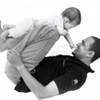Abstract
Los papás juegan muchos roles en la crianza de sus hijos. Algunos están involucrados en cada etapa de sus vidas, mientras que otros se concentran en uno o dos aspectos. Hoy, en los Estados Unidos los papás toman más responsabilidad en la crianza de sus hijos, comparado con las generaciones anteriores. Estudios de los comportamientos de la crianza sugieren que los papás tienden a concentrar sus esfuerzos en varias responsabilidades básicas. El rol de ellos tiende a ser definido por “las tres P y las dos C”
This 4-page fact sheet is the Spanish-language version of FCS2140/HE140: The Common Roles of Fathers: The Five Ps. It was written by Kate Fogarty and Garret D. Evans, and published by the UF Department of Family, Youth and Community Sciences, December 2011.
References
Badalament, J. (2008). Engaging modern dads in schools. Independent School, 67. [Online] Retrieved November 10, 2008 from http://www.pressomatic.com/tridentacademy/upload/msilgals//Why%20Schools%20Need%20to.pdf.
Diamond, M.J. (2007). My Father Before Me: How Fathers and Sons Influence Each Other Throughout Their Lives. New York: W. W. Norton & Company.
Doucet, A. (2006). Do Men Mother? Fathering, Care, and Domestic Responsibility. Toronto: University of Toronto Press.
Gordon, A., & Browne, K.W. (1996). Guiding Young Children in a Diverse Society. Boston, MA: Allyn & Bacon.
Jain, A., Belsky, J. & Crnic. K. (1996). Beyond fathering behaviors: Types of dads. Journal of Family Psychology, 10, 431-442. https://doi.org/10.1037/0893-3200.10.4.431
Kazura, K. (2000). Fathers' qualitative and quantitative involvement: An investigation of attachment, play, and social interactions. The Journal of Men's Studies, 91, 41-57. https://doi.org/10.3149/jms.0901.41
Marsiglio, W., Amato, P., Day, R.D., & Lamb, M.E. (2000). Scholarship on fatherhood in the 1990s and beyond. Journal of Marriage & the Family, 62, 1173-1191. https://doi.org/10.1111/j.1741-3737.2000.01173.x
Marsiglio, W. (1995). Fatherhood: Contemporary Theory, Research, and Social Policy. Thousand Oaks, CA: Sage. https://doi.org/10.4135/9781483327242
Nicholson, J.S., Howard, K.S., & Borkowski, J.G. (2008). Mental models for parenting: correlates of metaparenting among fathers of young children. Fathering: A Journal of Theory, Research, and Practice, 6, 39-61. https://doi.org/10.3149/fth.0601.39
Palkovitz, R. (2002). Involved fathering and child development: Advancing our understanding of good fathering. In C.S. Tamis-LeMonda & N. Cabrera (Eds.), Handbook of Father Involvement: Multidisciplinary Perspectives. Mahwah, NJ: Lawrence Erlbaum (pp. 119-140).
Palkovitz, R., & Palm, G. (2009). Transitions within fathering. Fathering: A Journal of Theory, Research, and Practice, 7, 3-22. https://doi.org/10.3149/fth.0701.3
Parke, R.D., McDowell, D.J., Kim, M., Killian, C., Dennis, J., Flyr, M.L., & Wild, M.N. (2002). Fathers' contributions to children's peer relationships. In C.S. Tamis-LeMonda & N. Cabrera (Eds.), Handbook of Father Involvement: Multidisciplinary Perspectives. Mahwah, NJ: Lawrence Erlbaum (pp. 141-167).
Pleck, J.H., & Masciadrelli, B.P. (2004). Paternal involvement by U.S. residential fathers: Levels, sources and consequences. In M.E. Lamb (Ed.), The Role of the Father in Child Development, 4th Edition (pp. 222-271). Hoboken, NJ: Wiley.
Wall, G., & Arnold, S. (2007). How involved is involved fathering? An exploration of the contemporary culture of fatherhood. Gender & Society, 21, 508-527. https://doi.org/10.1177/0891243207304973

